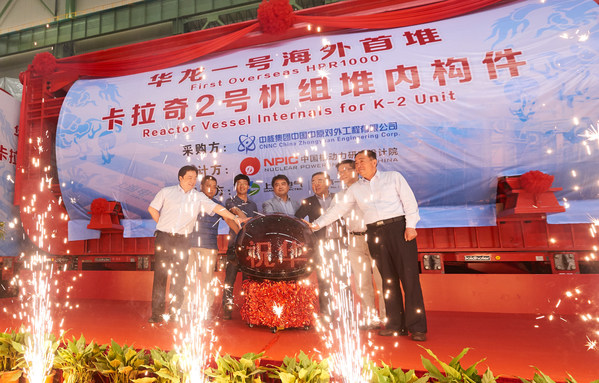 |
SHANGHAI, March 31, 2021 /PRNewswire/ -- Shanghai Electric (the "Company") (SEHK: 02727, SSE: 601727), the world's leading manufacturer and supplier of electric power generation equipment, industrial equipment, and integration services, has announced that Pakistan's Karachi Nuclear Power Plant Unit 2 (K-2), which incorporates the Generation III nuclear reactor Hualong One (HPR1000) that the company helped construct, was successfully connected to the grid on March 19 local time. Pakistan's Minister of Energy Omar Ayub Khan immediately posted an announcement on his Twitter account.

In May 2018, K-2's reactor vessel internals were shipped from Shanghai Electric's Shanghai No. 1 Machine Tool Works Co., Ltd. to its destination.
K-2 is slated to generate nearly 10 billion kilowatt-hours of electricity annually, meeting the annual electricity needs of one million people. It will help reduce standard coal consumption by 3.12 million tons per year, equivalent to planting more than 70 million trees. This project's construction has propelled the development of related industries in Pakistan, creating more than 10,000 jobs in the country and playing a significant role in furthering people's livelihoods and economic development.
K-2 was constructed under a contract signed between China National Nuclear Corporation and the Pakistan Atomic Energy Commission in 2013, and Shanghai Electric participated as the main equipment supplier to provide essential core components such as reactor internals and steam turbine generator sets.
Prior to K-2, the first international project to adopt the technology, the Hualong One was deployed for the first time at Unit 5 of the Fuqing Nuclear Power Plant in China, which entered commercial operation in January 2021. Over the course of nearly 20 years of R&D, the Hualong One completed 45 scientific and technological research projects, a landmark achievement of China's innovative development of nuclear power.
In 2015, Shanghai Electric began to manufacture K-2's reactor internals, which adopts the world's highest design standards, covers 236 categories of equipment, and is composed of 13,487 parts. The height stands at 11.036 meters, with a maximum diameter of 4.188 meters and a weight of approximately 160 tons.
For the K-2 project featuring the first export of China's 1000MW-class nuclear power unit, Shanghai Electric achieved a series of technological breakthroughs, which included applying advanced and mature low-voltage welding rotor technology to nuclear power steam turbines, greatly improving the equipment and technology's core competitiveness and breaking through procurement limitations on rotor forgings. Moreover, nearly all R&D for technologies and components used on the K-2 steam turbine generator sets were independently developed by domestic manufacturers.
In total, the Shanghai Electric project team successfully overcame 71 difficulties including technical and testing challenges. In the process, it independently-developed two R&D materials, five welding technologies, four inspection technologies, and seven other technological innovations, obtaining 10 manufacturing invention patents. In May 2018, 33 months into the project, K-2's reactor internals were successful shipped from Shanghai Electric's Shanghai No. 1 Machine Tool Works Co., Ltd. to its final destination. In July 2018, the improved 1100MW nuclear power generator set, independently developed by the company with full intellectual property rights, was sent to Pakistan. A few months later, in September, the K-2 steam turbine's low-pressure cylinder and rotor was completed, making it China's first overseas nuclear power project of 1000MW-class generation capacity.
Over the course of the project's commissioning and installation, the Shanghai Electric team had to confront the global pandemic and ensure the completion of K-2. To better serve the first overseas Hualong One, Shanghai Electric established its first overseas field service center for K-2 on January 9, 2019, duplicating its mature domestic field service model of a nuclear power project to ensure the unit's realization. Thanks to these efforts, K-2 was successfully connected, bringing cost-effective and reliable electricity to Pakistan.